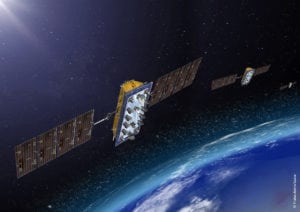LeoSat Responds to NSF for Antarctic Broadband Network

Artist rendition of LeoSat satellites. Photo: LeoSat
[Via Satellite 06-14-2016] The National Science Foundation (NSF) has invited LeoSat Enterprises, an emerging company with plans to launch a constellation of up to 108 Low-Earth Orbit (LEO) communications satellites, to respond to their Request for Information (RFI) for broadband data communications requirements in the South Pole and throughout the Antarctic continent.
NSF is an independent federal agency that supports fundamental research and education across all fields of science and engineering. Under a Presidential mandate, NSF manages the U.S. Antarctic Program, through which it coordinates all U.S. research on the Southernmost Continent and the surrounding ocean, funds scientists at institutions nationwide to carry out fieldwork and provides the logistical support for that fieldwork.
Data communication to and from the Polar regions is challenging and expensive. Building cable networks is hardly feasible from an economic perspective and satellite connections using the traditional GEO arc come at low speed, high costs and operational challenges. For bulk data there is no viable solution and all too often the data needs to be physically carried out to its destination. For research communities this causes serious delays and additional costs.
HNSF has reached out to LeoSat with a request to respond to the RFIs to allow the company’s information to be included in NSF’s planning. With the LeoSat network, the satellites will be placed in polar orbits, making the Antarctic region one of its best-served regions.
“As indeed our satellites are flown in polar planes, there is good fit with NSF’s requirements. In addition, the large data-transmission requirement, which, as per the two RFI’s is in the terabytes per day, can easily be delivered by the constellation that we plan to launch starting 2019. As such, we hope to work with the NSF in an effort to solve their bandwidth requirements in this challenging part of the world,” said LeoSat’s CEO Mark Rigolle.
When fully operational, LeosSat plan is to provide point-to-point data connections to and from anywhere on Earth without the need for any terrestrial landings or transport. The data would be able to travel in its native form while encrypted and secured from end to end, according to the company.